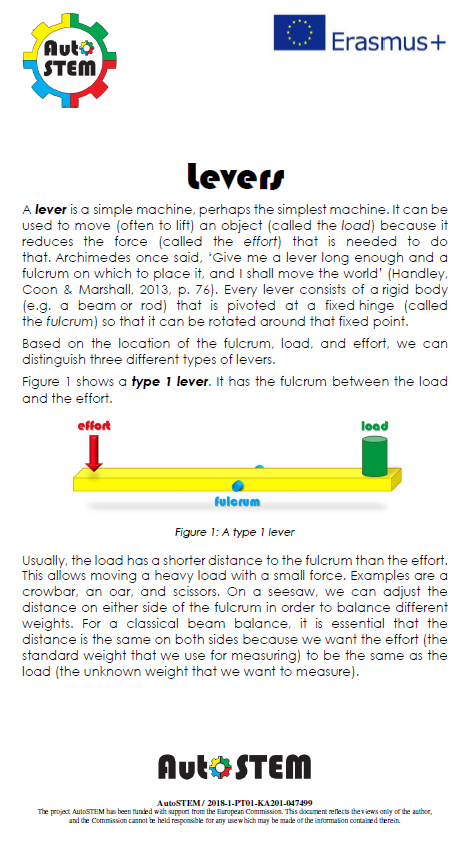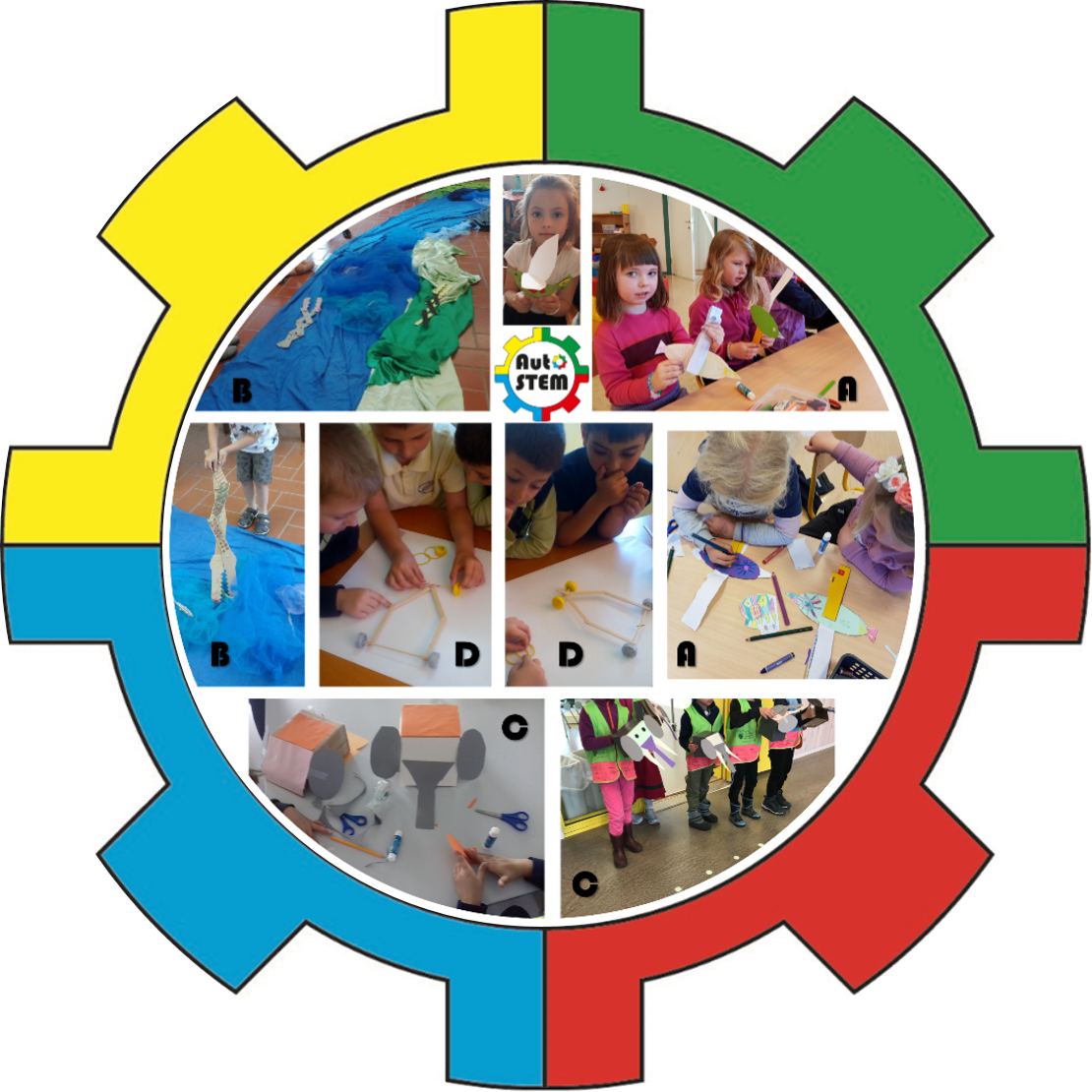Introduction
Physics the natural science that studies matter, its motion and behaviour through space and time, and the related entities of energy and force. The word derives from Ancient Greek ‘φυσική ἐπιστήμη’ (physikḗ epistḗmē), which means ‘knowledge of nature’. Physics is one of the most fundamental scientific disciplines. Since automata are mechanical toys, working with automata provides experiences with physical phenomena and concepts. Some of the AutoSTEM automata are designed with a special focus on specific physical concepts.
Force and energy
Force and energy are two fundamental concepts in classical physics that are directly related to automata. There are several possibilities for power sources that make the automata move. The simplest is that the children themselves provide the power. They can do this by using
- a turning handle – This is, for example, implemented in the Dancing Doll and the Drawbridge – or
- a simple lever handle – This is, for example, implemented in the Snapping Crocodile and the Talking Elephant.

Work
In both cases, the children apply force over a distance. By doing this, they do work. Work the energy transferred to or from an object via the application of force along a displacement. It can be represented as the product of force and displacement. Since energy is conserved, this product is constant. That means you can carry out the same work with a weaker force by applying it over a longer distance. This principle is used by the simplest of all machines, the lever. You can learn more about levers by reading our document about levers.
It is not only living things that can do work. Potential energy can be converted into work, for example,
Work by gravity
There are many different types of mechanisms that use gravitational potential energy. When using a lever, the load will push it down as soon as we stop applying the effort. We somehow use this in the Drawbridge. Usually, the gravitational force would pull down the bridge deck when we release the crank. In our model, however, the friction between the winch’s axle and its bearing is so high that it balances the gravitational force (the weight) of the bridge deck. Therefore, the raised bridge deck stays in place. In order to lower the bridge, you have to turn the hand crank in the opposite direction. The same principle is used in the Elevator.
If we coil a string around an axle and attach a mass to the other end, gravity will pull the mass downwards, causing the string to unwind, and the axle to turn around. We do not have automata that use this as a power source by default, but it could be added to several automata, for example, the Acrobat or the Dancing Doll.
Water power that sets a turbine into motion is another type of work by gravity because it is gravity that makes the water run downwards.
Work by a spring
A spring is an elastic object that stores elastic potential energy. In everyday language, the term often refers to coil springs, but there are many spring designs.
- You may use a coil spring (from a ball pen) in the Drawbridge to pull the bridge deck downwards.
- The Catapult uses a cantilever spring. That is a flat spring fixed only at one end like a cantilever, while the free-hanging end takes the load. The straw of the Eco-car 2 is a cantilever spring, too, but instead of taking the load, it pulls a string.
- A rubber band can be used as a spring in two different ways. In the Eco-car 1, the rubber band is a tension spring where energy is stored by stretching the material.
- The Returning Tin Can uses a rubber band as a torsion spring. That is a spring designed to be twisted rather than compressed or extended.
- A gas spring is a volume of compressed gas, like in a balloon. This will be further described in the next section.
Work by a gas
The air in a balloon can do work when it is released. We use this in our automata with a jet engine, the Balloon Boat, the Balloon Car, and the Amphicar. We must apply force to inflate the balloon. The balloon applies force on the enclosed air, pressing it out through the opening. According to Newton’s third law (action equals reaction), the force of the backwards streaming air (called the thrust) creates an equal force in opposite direction on the vehicle (called the propulsion) that pushes the vehicle forwards.
Wind power is another type of work by a gas. Our Wind Turbine uses wind that is artificially created by a hairdryer.
Kinetic energy
The kinetic energy of an object is the energy that it possesses due to its motion. It is defined as the work needed to accelerate a body of a given mass from rest to its stated velocity. Having gained this energy during its acceleration, the body maintains this kinetic energy unless its speed changes. In most cases on earth, however, a vehicle loses kinetic energy due to friction. The kinetic energy is transformed into thermal energy and the object’s speed decreases.
All our automata have moving parts. Thus, kinetic energy is involved and can be studied. We can distinguish between rotational kinetic energy (e.g. the rotation of wheels or of the Dancing Doll) and translational kinetic energy (e.g. the forward motion of a car).
Using the Catapult to teach physics K-12
As mentioned before, there is a lot of physics involved in all automata. In the following video, we use the Catapult as an example to explain how you can use it to teach physics on all levels of education from kindergarten to secondary school.
Reflection
- Choose another automaton.
- Write down the physics concepts and principles that you can teach with that automaton
- when children build it and
- when children play with it.
- Compare your ideas with the guidelines that you find in the toolbox.

